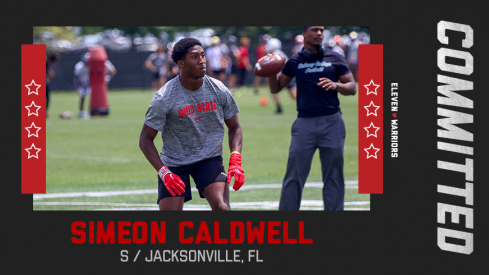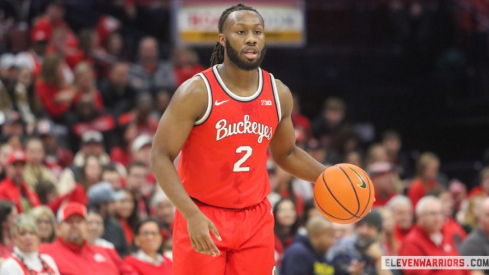Ohio State adds another top-100 safety as Simeon Caldwell commits to the Buckeyes.

In terms of issues to watch, the Ohio State defense certainly provides more questions than their offensive counterparts, simply by virtue of replacing numerous contributors. Fall practice has answered certain questions, such as Tyvis Powell locking down the "Star" nickel back position.
But outstanding issues remain: Who will join Shazier as the second linebacker in the nickel package? What will the defensive line rotation look like and how will the interior hold following Tommy Schutt's foot injury? How does Ohio State roll out dime coverage?
The game's almost here. Let's get to those questions.
Who Will be the Buckeyes' Second Nickel Linebacker?
Alternate title: "Has the light finally come on for Curtis Grant."
The Ohio State defense plays its 4-2-5 nickel defense at least 70% of the time.

In the nickel, the Buckeyes' Star defensive back replaces the Sam linebacker. That leaves the Ohio State nickel defense with two linebackers who both line up inside: the Mike (strong side); and Will (weak side). Since the Buckeyes overwhelmingly play nickel, the top two linebackers play far more than the third starter, making the battle for the top two linebacker positions crucial.
It is no surprise that Ryan Shazier will man the Will position. The second linebacker is more of a mystery. All indications are that Grant will get the first opportunity, with Josh Perry entering as the Sam in base sets. The Buckeye coaching staff has praised Grant throughout the pre-season and he certainly looks the part. It is fair to be skeptical of Grant's readiness to play, however, until he demonstrates it in live action. This is particularly true playing pass defense in space. This is the area where Grant struggled last fall, leading to his demotion.
If Grant is able to live up to his pre-season (and recruiting) hype, he will go a long way to solidifying the Mike linebacker position that has been a weak spot since Urban Meyer's arrival. Do not be surprised, however, if Perry also gets snaps as the second nickel linebacker. The coaching staff recently indicated that Grant and Perry are both in contention for the sport, suggesting the battle will continue into the season.
What is the Defensive Line Rotation and How does the Defensive Interior Hold Up?
It is well-known that Ohio State is replacing its entire defensive line. But many anticipate that the Buckeyes' new starters can capably step in. "Viper," aka weak end Noah Spence and "5 technique," aka strong defensive end Adolphus Washington have received the most attention. Both received extensive action as true freshman and look poised for breakout seasons.
Less well-known (and bigger question marks) are the interior linemen. But 3-technique Michael Bennett was a starter at 5-technique last season before a groin injury. He has consistently drawn high praise this pre-season. Bennett is better suited for 3-technique where he can use his quickness without needing to rely upon straight line speed. Nose guard Joel Hale also has ample game experience and can likely capably fill the largely thankless nose guard role.
Less known, however, is whether the Buckeye defensive line has sufficient depth. The Buckeye coaching staff would ideally like to play 8-9 defensive linemen. This goal received a setback with Tommy Schutt's broken foot. Schutt could be considered another starter and was set to play both nose and 3-technique. Schutt will apparently return by mid-season, which will certainly improve the defensive line's run stopping ability.
This makes depth particularly acute inside. The coaching staff recently moved Chase Farris back to defensive tackle, playing inside at 310 pounds. Meyer said that Farris' play has settled his concerns. Some may question why the Buckeyes would move one of their key offensive line backups to defense, but it shows the different nature of offense and defensive line. A coach does not want to play an offensive line backup unless and until one of their five starters is injured. As noted, however, defensive coaches want to liberally rotate up front. It remains to be seen, however, whether Farris can so quickly transition back to defense.
Freshman Joey Bosa and Michael Hill will also have the opportunity to fill this void. Bosa will perhaps play both 3 and 5 technique, with Hill and 3 and nose. Chris Carter has for whatever reason drawn extensive attention for heretofore limited playing time and production and now has the opportunity to demonstrate he deserves snaps. Jamal Marcus looks poised to get snaps at Viper. On third downs, look for Bennett and/or Washington to bump inside, with Spence and Washington or Marcus rushing from the ends.
The Ohio State defensive line is athletic and has players like Spence, Washington and Bennett that can get after the quarterback. The Bigger question is how the defensive front fares against a downhill run offense. This is where Schutt's loss is particularly acute. The line features explosive athletes but is somewhat undersized, particularly with Bennett at 3-technique. The Buckeye defense fortunately has opportunities to gain experience before facing such a rush offense, but will eventually have to demonstrate their ability to stop the run.
Does the Ohio State Defensive Coaching Staff Stick to the Script?
Working together for the first time, the Ohio State defensive coaching staff had difficulty establishing an identity last season, contributing to an uneven first half of the 2012 season. It is no coincidence that the Buckeye defense improved when the defensive coaching staff found a formula. On first and second down, Ohio State generally played cover 1 or quarter-quarter half against pro-style teams, with cover 4 match-up zone against spread offenses. On third down, the Buckeyes mix and matched man and zone blitzes with cover 2 and 3.
The matchup with Buffalo will provide evidence as to whether the Buckeye coaching staff will maintain this philosophy. Urban Meyer's recent comments regarding an increased use of man coverage suggests the Buckeyes are doubling down on the strategy. Cover 1 and cover 4 both employ man principles, so look for the Buckeye defense to liberally use those looks in early downs.
How does the Ohio State Coaching Staff Employ Dime Coverage?
One addendum to the Buckeyes' defensive toolbox is a dime package with six defensive backs. This is not a change of the above philosophy but provides the defensive coaching staff additional flexibility. As Meyer indicated, the Buckeyes want to use the dime to maximize the defense's ability to play man coverage. But the question remains – how will the Buckeyes employ six defensive backs?
To step back, the Buckeyes often use a three-man front with a stand-up Viper in third and long.

The Buckeye coaching staff uses this front to a) bump defensive linemen inside to increase the pass rush and b) provide flexibility in coverage and blitz capabilities.
Expect the Buckeyes to operate a dime package from this framework. The sixth defensive back replaces the second inside linebacker (the one not named Shazier) from the nickel package. In must-pass situations, six defensive backs can provide the Buckeyes the opportunity for a variety of both zone and man blitzes. For instance, a zone blitz generally brings five rushers with a 3 deep, 3 under zone. Defensive backs can more easily cover the larger zones. The dime takes advantage of the Buckeyes' depth in the defensive backfield while permitting more aggressive packages to get after the quarterback.
The Buffalo game will thus provide an opportunity to examine the Buckeye defensive coaching staff's answer to many questions. But position battles such as Grant and Perry may continue further into the fall.

